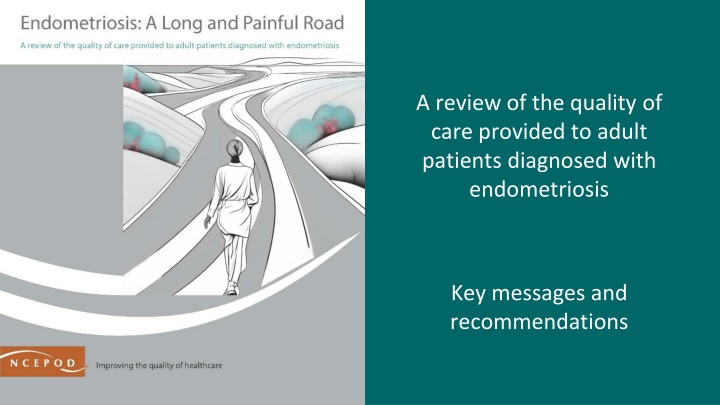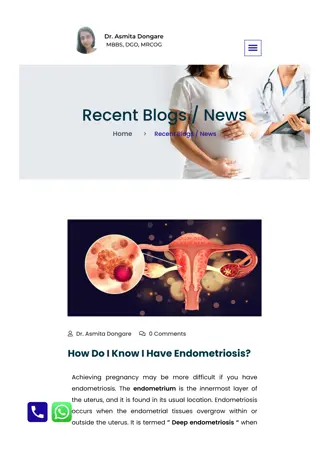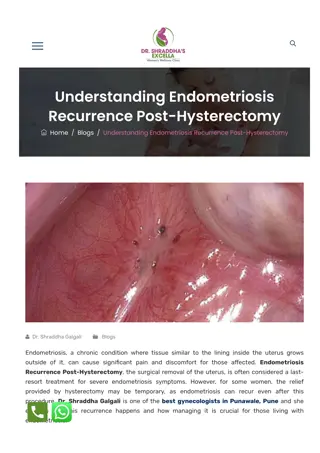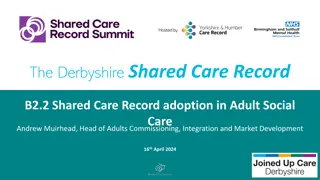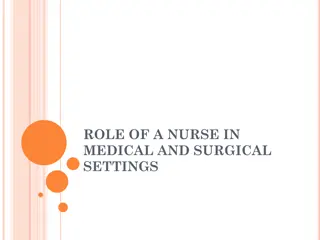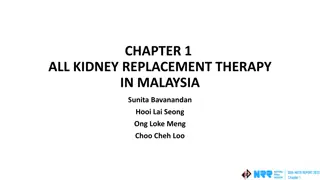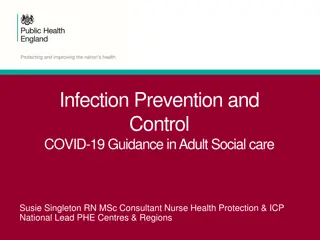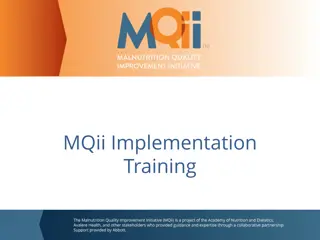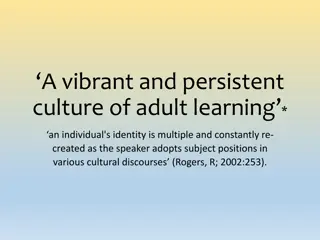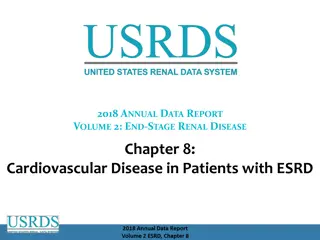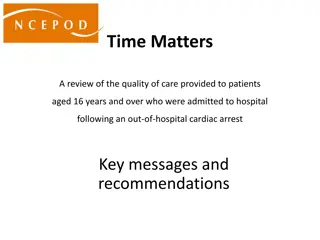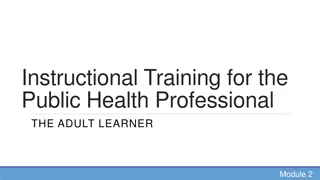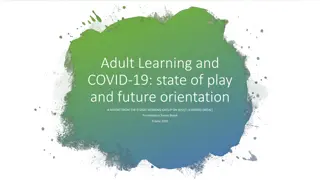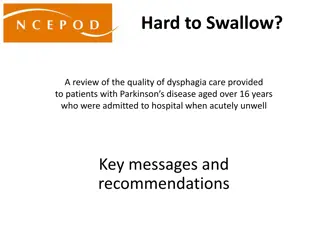Quality of Care for Adult Patients with Endometriosis: A Review
This review focuses on the quality of care provided to adult patients diagnosed with endometriosis. Key messages include the chronic nature of endometriosis, the importance of early recognition and timely management of symptoms, and the impact on patients' quality of life. Recommendations stress the need for improved pathways, earlier interventions, and better support services for managing the condition effectively.
Download Presentation

Please find below an Image/Link to download the presentation.
The content on the website is provided AS IS for your information and personal use only. It may not be sold, licensed, or shared on other websites without obtaining consent from the author.If you encounter any issues during the download, it is possible that the publisher has removed the file from their server.
You are allowed to download the files provided on this website for personal or commercial use, subject to the condition that they are used lawfully. All files are the property of their respective owners.
The content on the website is provided AS IS for your information and personal use only. It may not be sold, licensed, or shared on other websites without obtaining consent from the author.
E N D
Presentation Transcript
A review of the quality of care provided to adult patients diagnosed with endometriosis Key messages and recommendations
The Study Study population: Patients aged 18 or older with a primary surgical diagnosis of endometriosis admitted to hospital during the study timeframe: 1st February 2018 to 31st July 2020. Data sources: Clinician questionnaires Case reviews Organisational questionnaires Primary care notes Clinician survey Patient survey
Study population Inclusion criteria : Patients aged 18 or older with a primary surgical diagnosis of endometriosis admitted to hospital during the study timeframe: 1st February 2018 to 31st July 2020. Exclusions: Patients with adenomyosis without endometriosis
1 ENDOMETRIOSIS IS A CHRONIC CONDITION Unlike other chronic conditions, such as diabetes, there is no pathway for endometriosis. 124/238 (52.1%) patients experienced recurrence or persistence of endometriosis symptoms following laparoscopy
ENDOMETRIOSIS HAS SYMPTOMS AND SIGNS THAT NEED EARLIER RECOGNITION & APPROPRIATE TIMELY MANAGEMENT 2 Signs and symptoms of endometriosis need to be recognised and not just seen as troublesome periods. 546/941 (58.0%) patients surveyed had multiple visits to the GP before any investigations were undertaken or treatment initiated.
ENDOMETRIOSIS AFFECTS QUALITY OF LIFE. ALL PATIENTS SHOULD BE ASKED ABOUT ITS EFFECT ON THEIR LIFE 3 Access to supportive services would enable patients with endometriosis to manage their condition. 420/941 (44.6%) of survey respondents stated that they were not asked at any point about the impact of symptoms on their quality of life.
4 ENDOMETRIOSIS REQUIRES HOLISTIC, JOINED-UP, MULTIDISCIPLINARY CARE Multidisciplinary care is essential to ensure patients with endometriosis have all their care needs met. Reviewers found that only 27/242 (11.2%) patients were formally discussed in an MDT meeting and 28/215 (13.0%) patients who were not discussed should have been.
Public awareness and education Raise awareness about endometriosis symptoms with the public and patients, highlighting that it is a chronic condition and how they can seek help. Primary audiences: NHS England, Welsh Government, Northern Ireland Department of Health Supported by: Royal College of Obstetricians and Gynaecologists, Royal College of General Practitioners, Royal College of Surgeons, Royal College of Emergency Medicine, Royal College of Nursing, Royal College of Paediatrics and Child Health, Department for Education, Endometriosis UK, Endometriosis Cymru
Awareness of endometriosis as a chronic condition Raise awareness with all healthcare professionals that endometriosis is a chronic condition and should be treated as such. Primary audiences: Royal College of Obstetricians and Gynaecologists, Royal College of General Practitioners, Royal College of Surgeons, Royal College of Emergency Medicine, Royal College of Nursing, Royal College of Paediatrics and Child Health, Society for Acute Medicine, British Society for Gynaecological Endoscopy Supported by:NHS England, Welsh Government, Northern Ireland Department of Health
Training for healthcare professionals Improve training on the recognition of symptoms of endometriosis, such as pelvic pain and heavy menstrual bleeding. a. In primary care - to support healthcare professionals in the initial assessment, and any ongoing care of patients b. In secondary care - enhanced training on endometriosis should be made available for all healthcare professionals who might care for patients with endometriosis. Primary audiences: Royal College of Obstetricians and Gynaecologists, Royal College of General Practitioners, Royal College of Emergency Medicine, Royal College of Nursing, Royal College of Paediatrics and Child Health, British Society for Gynaecological Endoscopy Supported by: NHS England, Welsh Government, Northern Ireland Department of Health
Impact of endometriosis on quality of life Ask patients with endometriosis about the effects it has over and above physical symptoms, including its impact on their daily life and refer them as needed to support services (e.g. psychology/pain services), at all stages of the pathway. Primary audiences: Healthcare professionals in primary care and secondary care
Impact of endometriosis on quality of life Ensure multidisciplinary teams/clinical networks are set up and utilised across all healthcare settings to help agree treatment plans and support women with confirmed endometriosis. Input from specialties should be proportionate to the patient s needs. Primary audiences: Integrated care boards, Commissioners, Clinical Directors and Executive Boards Supported by: Royal College of Obstetricians and Gynaecologists, Royal College of General Practitioners, Royal College of Emergency Medicine, Royal College of Nursing, Royal College of Paediatrics and Child Health, British Society for Gynaecological Endoscopy, Commissioners
Multidisciplinary teams and clinical networks Ensure multidisciplinary teams/clinical networks are set up and utilised across all healthcare settings to help agree treatment plans and support women with confirmed endometriosis. Input from specialties should be proportionate to the patient s needs. Primary audiences: Integrated care boards, Commissioners, Clinical Directors and Executive Boards Supported by: Royal College of Obstetricians and Gynaecologists, Royal College of General Practitioners, Royal College of Emergency Medicine, Royal College of Nursing, Royal College of Paediatrics and Child Health, British Society for Gynaecological Endoscopy, Commissioners
Medical/ pain management for endometriosis Manage pain effectively for patients who have endometriosis: a. Set a low threshold for the prescription of analgesia b. Set a low threshold for hormonal treatment which may improve pain as well as other symptoms while always considering fertility intentions c. Refer to pain management services as needed d. In parallel, refer patients for non-medical pain management e.g. physiotherapy Primary audiences: All healthcare professionals in primary, secondary, and specialist care who are in contact with people who have endometriosis Supported by: Royal College of General Practitioners
Consent for laparoscopies for endometriosis Provide patients with clear, written information as part of the process that allows the patient to give informed consent for the laparoscopic diagnosis/treatment of endometriosis. This should form the basis of a documented discussion with the surgeon before the day of surgery. Include: a. What the procedure involves b. The purpose of the procedure e.g. to diagnose, stage, treat the symptoms of endometriosis, or a combination of these c. What the patient s expectations are d. The possible effects on endometriosis symptoms e. Risks, benefits and limitations f. The need for further laparoscopic/open surgery for recurrent endometriosis or if complications arise This is consistent with NICE guideline NG73 Primary audiences: Consultant surgeons
Discharge, follow-up and readmission Provide patients with clear, written information at discharge following laparoscopic diagnosis/treatment of endometriosis, including who to contact and how to initiate direct access back into the endometriosis care pathway. a. Who to contact if they have any concerns, e.g. GP, endometriosis clinical nurse specialists, consultant b. The follow-up plan and ongoing management of the endometriosis c. The option of patient-initiated follow-up d. Types and dosages of medication they are on at discharge, including analgesia and hormone therapy e. The consideration of bone health for people with endometriosis on long-term hormonal medication, including nutrition, weight-bearing exercise and alcohol intake Primary audiences: All healthcare professionals who care for patients with endometriosis Supported by: Clinical Directors
The endometriosis care pathway Formalise a care pathway for patients with or suspected to have endometriosis. This pathway should include implementation of NICE guideline NG73, the European Society of Human Reproduction and Embryology (ESHRE) endometriosis guidelines, as well as the recommendations from this report. Primary audiences: Royal College of Obstetricians and Gynaecologists, Royal College of General Practitioners, Royal College of Surgeons, Royal College of Emergency Medicine, Royal College of Nursing, Royal College of Paediatrics and Child Health, Society for Acute Medicine, British Society for Gynaecological Endoscopy, British medical ultrasound society, Pelvic Obstetric and Gynaecological Physiotherapy Supported by:NHS England, Welsh Government, Northern Ireland Department of Health
Further opportunities to improve endometriosis care a. Collect surgical outcome data, including patient-reported outcomes, for benchmarking. b. Review local practice against NICE guideline NG73, the recommendations in this report. c. Undertake clinical trials to ascertain the efficacy of surgery for endometriosis- associated symptoms, especially for minimal or mild endometriosis. d. Assess the use of pain medication, and the medical treatment of endometriosis. e. Explore the use of imaging modalities in the diagnosis of endometriosis. Primary audiences: Grant-making bodies such as the National Institute for Health and Care Research or Medical Research Council Supported by: Relevant Royal Colleges
REPORT and TOOLS www.ncepod.org.uk/2024endometriosis Report Summary Infographic Recommendation checklist Audit tool Driver diagram Fishbone diagram Commissioners guide
